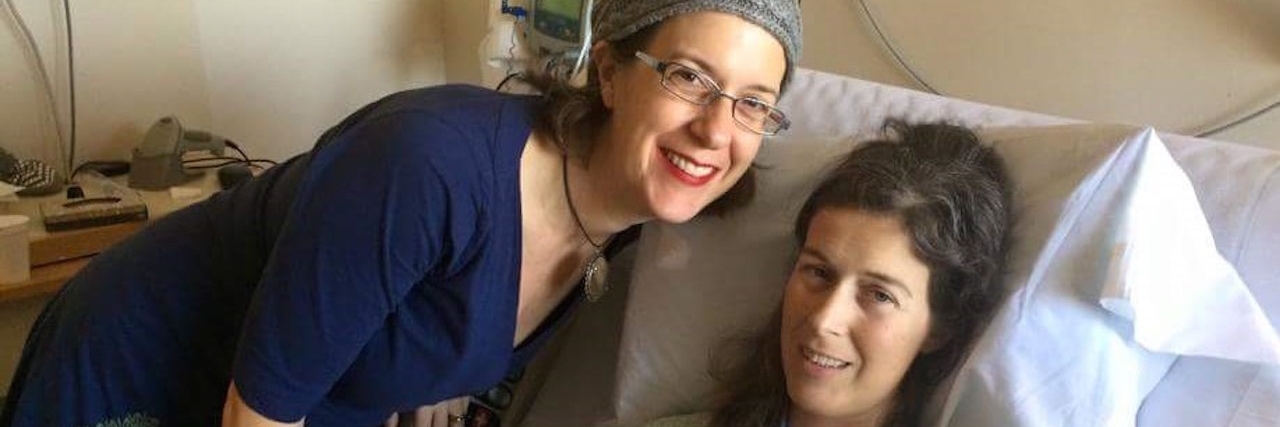When I'm Asked 'What Do You Do?' as a Woman With a Chronic Illness
“What do you do?” A simple question that I find extremely complicated to answer these days. I can tell you what I have done: traveled by raft down wilderness rivers, rock climbed, backpacked through the Rockies, and mountain biked down ski slopes. I can explain my undergraduate and my master’s degrees, tell you about traveling to all 50 states and 21 countries. If you want to know about my career, I can tell you I was a naturalist, a rainforest ecologist, a paleontologist and a science teacher.
It doesn’t take long for the listener to notice that the verbs and titles I use are all in past tense. Why? What I do in the present tense makes a poor conversation starter, especially if you don’t know what I was. Right now, what I do is take care of my body, manage my health well enough to lovingly care for and nurture my two 9-year-old sons. I’m learning to care for my body as if it is my third child that must get to bed on time or she will fall asleep at the restaurant, or be unable to walk to the car from the furthest corner of the zoo if I ignore when she cries “My feet hurt, can we please stop walking!” I take my body to the pool to ensure it gets exercise to preserve my strength and range of motion of body parts. Also, a great deal of my time is spent preparing nutritious food I can tolerate, that don’t exacerbate inflammation, and that taste great, since eating is already a chore due to chronic abdominal pain and lack of an appetite. Like feeding a picky toddler, I have to delicately coax myself to get in enough calories to live.
Why? They are probably wondering why a 38-year-old athletic-looking woman who did so many amazing things spends most of her time taking care of herself as if she is a child? Because starting around the time I was 14, I would find myself using every Ace bandage I could find to wrap my aching legs and arms, figuring I was sore from track practice. At 15, my mom found me sobbing in my upstairs bedroom with my pants around my ankles before school, unable to bend down and pull them up because the inflammation in my hips was so severe. At 16, I would wake up with fevers of 103 degrees Fahrenheit screaming in hallucinatory agony as my shoulder would be shoved out of its socket, causing the joint to be hot, bruised, useless and excruciating, then the next day completely fine. A few weeks later, the same thing would happen to the other shoulder, then a knee, a wrist, an ankle…
Finally, two weeks before leaving for college and turning 18, a specialist gave my suffering a name: rheumatoid arthritis. What I remember was feeling silly for being in so much pain from “arthritis.” I would soon learn to hate that arthritis was part of the name of my disease, because it allowed others to be dismissive of my suffering because they too had arthritis in their thumb, or think I was too young to have arthritis, confusing rheumatoid with osteoarthritis that is caused from aging.
Over the next 20 years, I grew confident and skilled in my profession as a teacher, I got married, I adopted two sons, and the disease continued its ruthless attacks and destruction of my body. Each additional joint that succumbed to the rheumatoid forced me to make tough choices and sacrifices in order to have any hope of peace between me and my body. Then, it finally happened: I had used every single bargaining tool I was willing to sacrifice and I was still losing the war.
My rheumatologist and I were trying everything possible to slow down my free fall, yet rheumatoid continued to gain new territory despite our efforts. Defeated, I went to my principal and explained that I only knew how to teach 100 percent, but felt like I only had five percent to give, and I needed her to find someone to take care of my students for the rest of the year. The next day I had an appointment with my rheumatologist, who decided I need to be admitted to the hospital, where I spent eight days. It was from my hospital bed that I made the phone call to Social Security and asked to apply for disability. A word, a label, a concept that I had fought against valiantly for more than 20 years.
I never got to go back in my classroom, and since then I have had to give up most of the verbs associated with who I was. I no longer climb, run, mountain bike, kayak or backpack. I no longer work as a naturalist, paleontologist or science teacher. I also am no longer a wife or a gardener, and I shy away from answering the question “What do you do? “
I am still a teacher, learning to teach through writing, and I am still fascinated by the science all around me. I am still a mother to two amazing sons, a sister, a daughter and a patient. What I do, now, is stay alive by making the maintenance of my body and management of my disease as much of a priority as the care of my sons. What I do is survive first, then find a way to be alive so the world can see that what I am and who am I is not depended on what I can or can no longer do.
The Mighty is asking the following: Tell us one thing your loved ones might not know about your experience with disability, disease or mental illness. What would you say to teach them? Check out our Submit a Story page for more about our submission guidelines.

